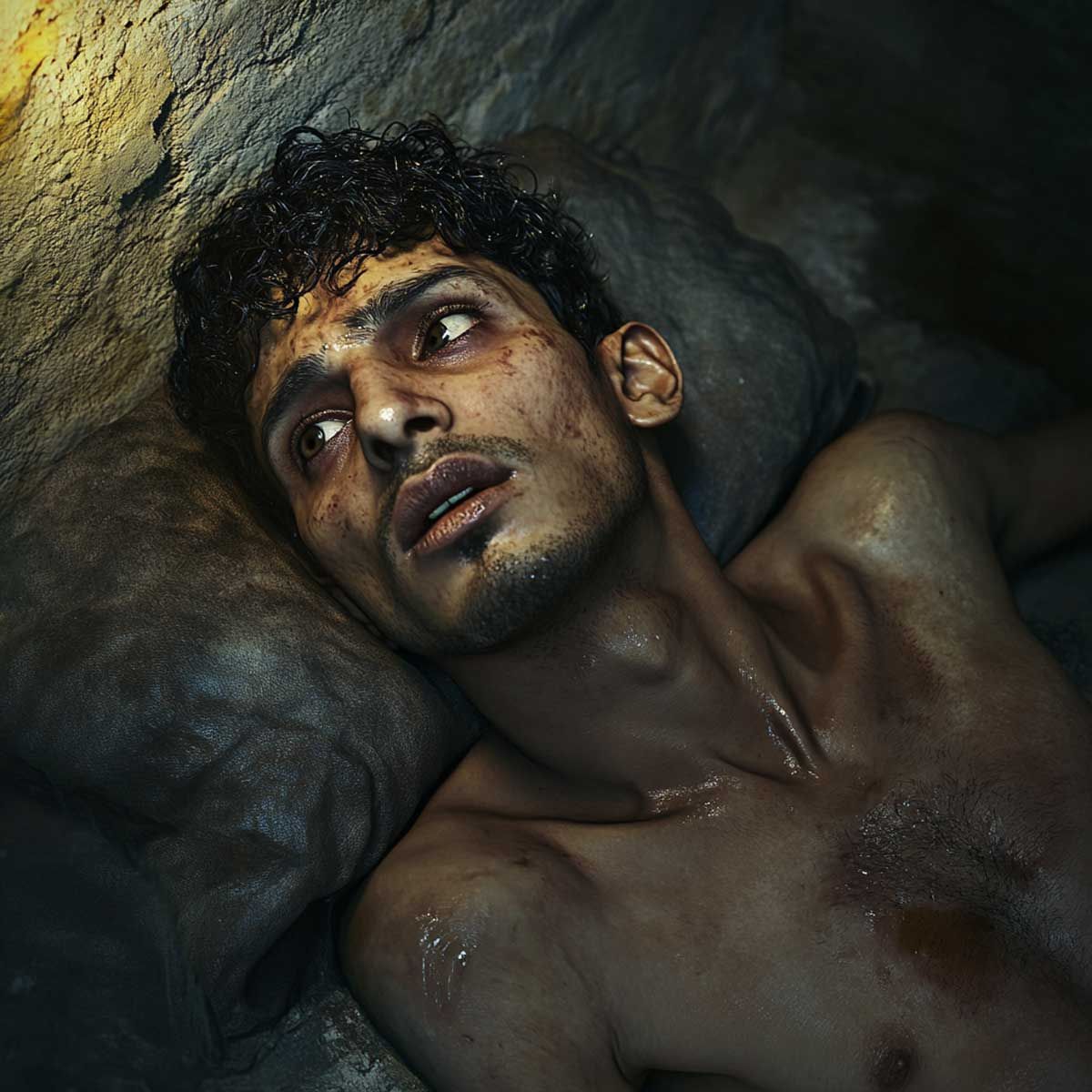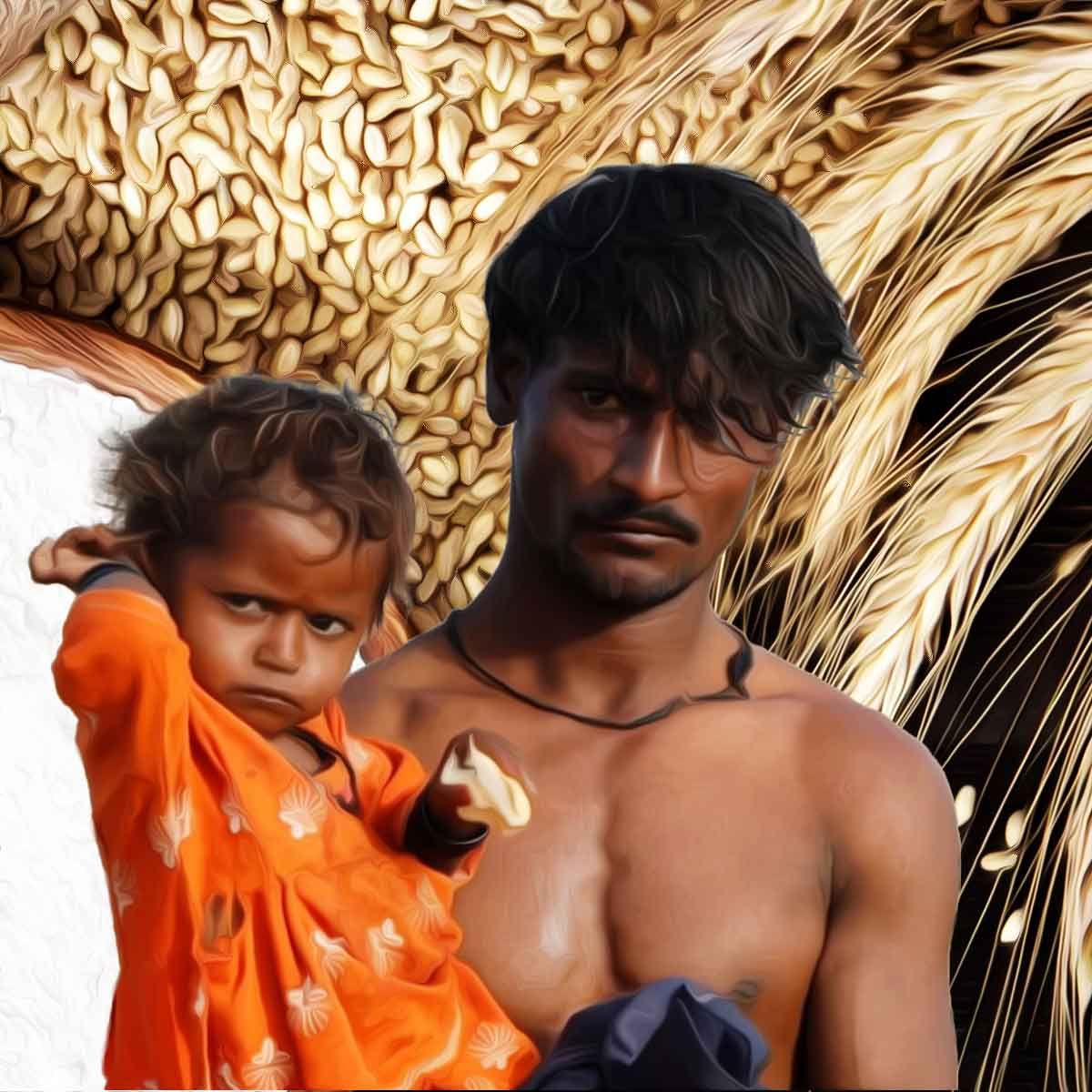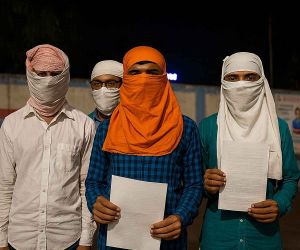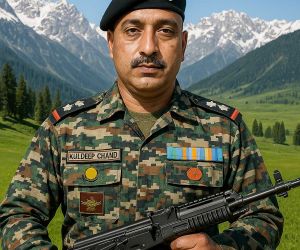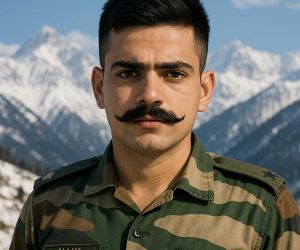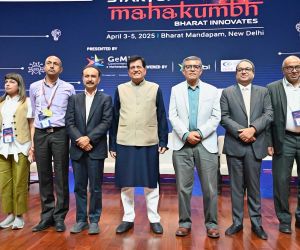MORE COVERAGE
Twitter Coverage
Satyaagrah
Written on
Satyaagrah
Written on
Satyaagrah
Written on
Satyaagrah
Written on
Satyaagrah
Written on
JOIN SATYAAGRAH SOCIAL MEDIA
Adding to the grim tally, Indian students Nivesh Mukka and Goutham Parsi killed in a fatal car crash in Arizona; both enrolled at Arizona State University, their untimely demise underscores the ongoing safety challenges faced by Indian students in the US

On a somber Saturday night near Lake Pleasant in Arizona, a severe head-on collision resulted in the tragic deaths of two students from Arizona State University. Nivesh Mukka and Goutham Parsi, both 19 years old and natives of Telangana in southern India, lost their lives in this tragic event.
|
Both victims were pursuing their studies as international students at Arizona State University. The community at the university has been deeply affected by this loss.
On April 22, Fox10 Phoenix reported on the incident, quoting a university spokesperson who detailed the tragedy: "A devastating head-on collision near Lake Pleasant in Arizona on Saturday night claimed the lives of two Indian students studying at Arizona State University." The report also highlighted the efforts being made to support the grieving community: "ASU’s International Students and Scholars Center is working with the Dean of Students, counseling services, and housing representatives to identify their student groups, friends, roommates, etc., so we can offer any needed support."
The accident occurred around 6:15 p.m. on April 20, involving a Kia Forte and a Ford F-150 near State Route 74 and Castle Hot Springs Road. According to preliminary investigations, the southbound Ford F-150 and the northbound Kia Forte collided head-on. The authorities are still investigating the exact circumstances that led to this fatal crash.
The harrowing accident that claimed the lives of Nivesh Mukka and Goutham Parsi occurred approximately 65 miles northwest of Arizona State University's Tempe campus. This location underscores the remoteness of the accident site from the central university area, which posed additional challenges for emergency response and later, for the university community reaching out to assist.
The crash had devastating effects on the occupants of both involved vehicles. The Kia Forte, which Mukka and Parsi were passengers in, took the brunt of the impact. The driver of the Kia Forte sustained serious injuries while Mukka and Parsi tragically did not survive. In the Ford F-150, one person also suffered serious injuries due to the collision. The severity of the crash highlights the critical nature of vehicle safety and emergency response in such incidents.
According to a report by The Times of India, both Parsi and Mukka were enrolled in the Bachelor of Science program in computer science at Arizona State University. Parsi had begun his academic journey at the university in 2022, and Mukka had started a year earlier. Their choice of major reflects their aspirations and commitment to their field of study.
Further personal details emerge about Goutham Parsi, who had plans to visit his home country, India, and had already purchased tickets for his journey. This detail about his planned trip adds a layer of poignancy to the tragedy. Parsi came from a family deeply embedded in the gold trade in the Jangaon district; his father, P. Kamal Kumar Gupta, is a significant figure in this industry. This background information provides insight into the personal lives and community ties of the students whose lives were cut tragically short.
Nivesh Mukka hailed from Karimnagar and was the son of esteemed doctors, Naveen and Swathi. The medical profession of his parents reflects the high educational and career aspirations that characterized Mukka’s own academic journey. This background underscores the profound impact of his loss, not only to his family but also to the broader academic community that anticipated his future contributions.
The unfortunate passing of Mukka and Goutham Parsi is part of a concerning pattern of incidents involving Indian or Indian-American students in the United States. Since the beginning of 2023, there have been more than a dozen fatalities involving students from this community under various mysterious circumstances on US campuses.
These incidents have greatly alarmed the community, triggering intense discussions and concerns about the safety and well-being of students. The nature of these tragedies, ranging from suspected homicides to accidental deaths, highlights the complex risks that students face while studying abroad. This has prompted calls for increased safety measures and support systems on campuses to protect students and ensure their well-being as they pursue their educational goals in the United States.
|
Tragic deaths of Indian-origin students in the US raise alarms over safety
The recent fatalities involving Indian and Indian-American students in the United States have not shown a clear pattern. However, the cold and harsh winter conditions have been identified as a contributing factor in at least four of these deaths over the past few weeks. This alarming trend highlights the array of challenges faced by students far from home, sometimes in environments vastly different from what they are accustomed to.
One of the recent tragic incidents involved Sameer Kamath, a doctoral student in mechanical engineering at Purdue University. According to the local coroner's autopsy report, Kamath died from a self-inflicted gunshot wound. His body was discovered on February 5 at the Niches Crow’s Grove Nature Preserve in Williamsport, Indiana. Kamath, aged 23, was pursuing his Ph.D. and was anticipated to graduate in 2025.
Another distressing case was that of Shreyas Reddy Benigeri, a former student of BITS Pilani and a current graduate student at the Lindner School of Business, University of Cincinnati. Benigeri's death was recently reported, and according to a statement by the Indian Consulate in New York via a tweet, no "foul play" was suspected. The circumstances surrounding his death suggest he may have died from natural causes or by his own hand.
These incidents have significantly raised concerns within the Indian community and among international students in general. They underscore the need for better support systems at educational institutions to address not only academic and career challenges but also mental health and adaptation to new environments.
Another Indian student from Purdue University found dead (February 7, 2024)
Benigeri's death marked the third loss of an Indian or Indian American student within a single week, following the tragic news of Neel Acharya and Vivek Saini. This series of deaths has alarmed both the Indian community and the broader academic circles in the United States, prompting concerns over student safety.
Neel Acharya, a diligent undergraduate at Purdue University, pursued a dual major in computer science and data science at the John Martinson Honors College. He was an alumnus of St. Mary’s School in Pune. Acharya's life was tragically cut short when his body was found on the university campus, one day after an Uber driver had dropped him off late at night. Authorities, after conducting an autopsy, reported no signs of trauma on Acharya's body and ruled out foul play. The community is now anxiously awaiting toxicology results to determine if the severely cold temperatures that night played a role in his unfortunate death.
Amidst these somber reports, the community also learned of the brutal murder of Vivek Saini, a 25-year-old Indian student. Saini's death was particularly shocking as it occurred at a convenience store in Lithonia, Georgia, where he worked part-time. The murder, captured on camera, showed a homeless drug addict striking Saini nearly 50 times on the head with a hammer. What adds to the horror is that Saini had previously shown kindness to the murderer by providing him with food and warm clothing. Saini had moved to the United States two years ago after completing his BTech in Computer Science from Chandigarh University. He had recently earned an MBA from Alabama University and was actively seeking employment.
Indian student killed by homeless man in Georgia (January 29, 2024)
The brutality of Saini’s murder brings to mind another appalling incident from the previous year. Varun Raj Pucha, a graduate student at Valparaiso University in Indiana, was studying for a master’s degree in information technology. He was fatally stabbed by a stranger at a gym where he was working out. The unprovoked attack targeted his head, and the knife wound penetrated the brain stem, leading to immediate fatality. These horrific events have cast a dark shadow over the safety of Indian students in the US, intensifying calls for enhanced protective measures and support systems in academic institutions.
Neel Acharya, missing Indian student, found dead (January 30, 2024)
The Indian American community was deeply shaken by another tragic event last month when the body of Akul Dhawan, an undergraduate student, was discovered on the campus of the University of Illinois. This incident sparked considerable unrest among the community, especially following allegations by Dhawan's parents who have accused the police of negligence in their search efforts. Despite being reported missing the previous night, Dhawan's body was found more than nine hours later, shockingly less than 400 feet from the location he was last seen. On the night Dhawan went missing, temperatures plummeted below zero degrees, and the autopsy revealed signs of hypothermic skin changes, suggesting he died from exposure to the severe cold.
His father, Ish Dhawan, expressed his dismay and sorrow, saying, "This is bizarre, that a kid is never found who was just less than a block, like one minute away, sitting there, dead, frozen to death." He added, "Imagine as a dad and mom what’s going through in our mind. I visualize his every minute that my son froze to death on a university campus." Akul Dhawan, only 18, was studying in the University of Illinois’ Department of Electrical and Computer Engineering against his parents' wishes, who had preferred him to study closer to their home in California.
Akul Dhawan’s family accuses Illinois University police of negligence (January 26, 2024)
The tragic trend continued elsewhere as the harsh winter conditions also played a critical role in the deaths of two computer science students at Sacred Heart University in Connecticut. Autopsy reports for Gattu Dinesh, aged 22 from Telangana, and R Nikesh, aged 22 from Andhra Pradesh, confirmed that they succumbed to carbon monoxide poisoning emitted from a room heater during the bitterly cold month.
In a broader context, the frequency of such tragic incidents involving Indian students abroad has prompted official responses. India’s External Affairs Minister S. Jaishankar, addressing the Lok Sabha, highlighted the disturbing trend of student deaths overseas. In a written reply, he noted that since 2018, there have been "403 incidents of death of Indian students abroad due to various reasons, including natural causes, accidents, and medical conditions." The data provided included deaths in several countries: 91 in Canada, 48 in the UK, 35 in Australia, 40 in Russia, 36 in the USA, 21 in Ukraine, 14 in Cyprus, 20 in Germany, 10 in Italy, and nine each in China, Kyrgyzstan, and Qatar.
Parents demand answers over Indian student’s death in Illinois (January 25, 2024)
The series of deaths among Indian students in the US has been both alarming and heart-wrenching. Among these tragedies was the case of Aaditya Adlakha, a 26-year-old doctoral student at the University of Cincinnati College of Medicine. In November of the previous year, Adlakha was found grievously wounded inside a car, having been shot. Despite immediate medical attention, he succumbed to his injuries. He was at the time a fourth-year student in the molecular and developmental biology program. Remembering him, Dr. Andrew Filak Jr., senior vice president for health affairs, and Christian Holmes, professor and dean of the College of Medicine, shared in a statement, "He was much-loved, exceedingly kind and humorous, intelligent and sharp, whose research was described as novel and transformative."
Gun violence
The scourge of gun violence claimed several lives last year, reflecting a disturbing trend of increased insecurity. Among the victims was Jude Chacko, a 21-year-old student at Temple University. Chacko was fatally shot in the forehead by an unidentified assailant in Philadelphia in June. This brutal act of violence shocked the student community and heightened concerns over student safety in urban areas.
Indian student killed by homeless man in Georgia (January 29, 2024)
The peril of gun-related incidents continued, as seen in the case of Veera Saiesh, a 21-year-old student from Andhra Pradesh. Saiesh was killed during what is suspected to have been a robbery at a gas station in Columbus, Ohio, in April. This incident was closely followed by the murder of Devsish Nandepu, a 23-year-old, who was shot by armed robbers at Princeton Park in Chicago in January of the previous year. Going further back, in 2019, Neil Purush Kumar, another student at the University of Troy, Alabama, faced a similar fate when he was shot dead at a convenience store.
In a particularly tragic incident in 2019, Abhishek Bhat, a University of California student, was shot and killed while working at a motel in San Bernardino on Thanksgiving Day. Mere minutes before his death, he had been speaking to his family in India over the phone, highlighting the sudden and brutal nature of the attack. These incidents have cast a long shadow over the safety of Indian students in the US, leading to increased calls for action to ensure their protection and to address the broader issue of gun violence affecting the community.
Indian American student shot dead in Philadelphia (June 2, 2023)
In June 2019, the Indian student community faced a tragic loss when Ruth George, a 19-year-old at the University of Chicago, was strangled to death inside her car. This brutal act shocked the community and highlighted the dangers that students can face even in seemingly safe environments. Later, in October 2022, another disturbing incident occurred at Purdue University. Varun Manish Chheda, an undergraduate student studying data science and a semi-finalist in the National Merit Scholarship Program, was killed by his roommate while he was playing a video game. The roommate, Ji Min Sha, a 22-year-old junior cybersecurity major from South Korea, stabbed Chheda to death in their dorm room, adding to the community's distress and raising serious concerns about student safety on campus.
Man charged with murder of Indian American student Ruth George (November 26, 2019)
In a similarly horrifying event from July 2016, Gundam Sankirth, a 24-year-old student from Hyderabad, was killed by his roommate, Sai Sandeep Goud Kurremula, who was 27 and also from Hyderabad. This incident took place in Austin, Texas, and added another tragic story to the growing list of safety concerns involving Indian students in the U.S. The community was still grappling with these issues when, a month before Chheda's death, another devastating event occurred involving an Indian student. Jaahnavi Kandula was struck and killed by a police patrol car in Seattle. Following her death, a Seattle police officer was recorded making highly inappropriate comments about her value, stating, "Yeah, just write a check. $11,000. She was 26 anyways. She had limited value." This remark caused significant outrage and highlighted the insensitivity that can pervade responses to such tragic incidents, further disturbing the community and leading to demands for accountability and respect for the lives of international students.
Police body seeks action against cop joking over Indian student’s death (September 21, 2023)
The Indian American community was deeply troubled following an incident involving insensitive remarks made by a Seattle police officer after the tragic death of Jaahnavi Kandula. Kandula, a student at Northeastern University, was fatally struck by a police patrol car. The officer's remarks sparked a massive uproar, leading to rallies in multiple cities across the U.S. by Indian Americans protesting the callous comments. In response, Seattle’s Mayor Bruce Harrell issued an apology letter, expressing his shared grief and acknowledging Jaahnavi's character and potential: "While I did not know Jaahnavi personally, I understand that she was a caring, kind, and smart young woman who had a very bright and promising future ahead of her. I share your grief that her life was tragically cut short." This tragedy highlighted the broader struggles faced by Indian students abroad, particularly the sacrifices they and their families make, as illustrated by Kandula's mother who had taken on significant financial debt to fund her daughter’s education in the U.S.
In 2016, another heart-wrenching incident occurred when Shani Patel, an economics student at Rutgers University, was murdered in a targeted shooting at her off-campus apartment in Newark. This incident was reported by The New York Times as a deliberate attempt on her life, underscoring the dangers students may face even while pursuing their studies.
Northeastern University mourns loss of Indian American student (February 1, 2023)
The grief within the Indian student community was compounded by several other tragic events over the years. In December 2017, the murder of Dharampreet Singh Jassar, a Fresno State University student studying accounting and criminal justice, by Amritraj Singh Athwal, sent shockwaves through the community. This case, along with others such as the killings of Mamidala Vamshi Reddy in 2017 during a robbery attempt, Sandesh Rajendra Dhavan in a hotel room by a colleague, and Sai Kiran who was shot dead for refusing to surrender his iPhone, have highlighted the critical security concerns faced by Indian students in the U.S. Another tragic case involved Vaibhev Loomba, who was found dead after a fraternity party at Berkeley, and Prashanth Goinaka, who was shot dead in Oklahoma while working at a convenience store.
The history of violence against Indian students includes one of the most chilling cases in 2007 at Louisiana State University, where two Ph.D. students from Andhra Pradesh, Chandrasekhar Reddy Komma and Kiran Kumar Allam, were murdered. They were followed into Allam’s apartment by two or three assailants, where Komma was bound with a computer cable and both were shot dead as Allam possibly tried to escape. These students were later granted posthumous degrees by LSU, a somber recognition of their unfulfilled potential and the profound loss experienced by the academic community.
Pravin Varughese
The case of Pravin Varughese has captivated the Indian American community for over a decade. February 12th marked the tenth anniversary of the discovery of Varughese’s body in Carbondale, Illinois. This case gained notoriety following a sensational murder trial where Gaege Bethune, then aged 23, was initially convicted of first-degree murder in the 2014 death of Varughese, a 19-year-old student at Southern Illinois University. The circumstances of the case were particularly grim, as Bethune was accused of beating and robbing Varughese after offering him a ride on a bitterly cold February night, and then abandoning the injured student in a wooded area. However, in a dramatic turn of events, the guilty verdict was overturned by a judge in September of the same year, and Bethune was released on bond and is now free. The Varughese family has not given up their fight for justice, appealing the decision, with the possibility that the case may continue.
In a recent interview with The American Bazaar, Lovely Varughese, Pravin’s mother, discussed the broader implications of her son’s case in light of other recent tragic events involving Indian students like Neel Acharya and Akul Dhawan. She expressed frustration with the investigative processes, stating, "I think the problem is there is nobody to talk for them [the families of the students] here. You know, so it is like, it’s all case shut. Even today my husband was saying the police will say, ‘oh, no foul play suspected.’ That’s the end of it, case closed. That’s exactly what they told us [about Pravin]. ‘No foul play suspected.’” She also commented on the handling of Acharya's case, noting his academic prowess and the strange circumstances of his death, "The Purdue University student (Acharya) was doing a double major. My God, what a smart student. Even that they said his phone was found somewhere in the field and he was found on campus. So, I don’t know how they can say no foul play [is] suspected. You know, nobody’s going to throw their phone in the field and come and just die. It’s common sense but to me, unless somebody’s there to talk for them nothing will happen."
When asked about any similarities between the deaths of Pravin and Akul Dhawan, she highlighted a pattern of premature conclusions by authorities, "I mean, the similarity in the sense, like they are too quick, you know, to make an assumption [that] there is no foul play… even before an autopsy. I don’t know the details of these two cases, but from what I’m hearing is like, you know, they [authorities] are not doing anything. That’s exactly what was happening with Pravin too. If we did not make all that noise and raise all this, we were done too." This poignant statement underscores a common frustration felt by many families seeking justice for their loved ones, emphasizing the need for diligent and thorough investigations in such cases.
Trial of Pravin Varughese murder case begins on Monday (June 4, 2018)
The trial for the murder of Pravin Varughese, a case that has gripped the Indian American community, is set to begin. In an interview, Lovely Varughese, Pravin's mother, shared her frustrations about the disparities in media attention and support that different communities receive. She expressed a feeling of neglect when she said, "So, I always think when I hear cases like these, I’m like why is this, why don’t we get the same attention like the other communities get. Even when they are missing, you now, like about the search, it’s all over the news, in the national media and all that. But then when it comes to our kids, we are lucky if it even gets to the local channel. You know, and these kids are such smart kids, otherwise they won’t even make it here [to the US].”
She also questioned the role of Indian consulates in such cases, highlighting her own experience, "And I don’t know how much this Indian consulate is doing. In our case, they couldn’t do anything because Pravin was born here. And we all are US citizens too. So, they said they couldn’t do anything...” She hoped for more proactive involvement from the consulates, "Yeah, but for these kids, I would hope these Indian consulates will take a little bit more aggressive inquiry and get to the bottom of it. You know these are real human lives. I mean, the parents and their kids over here, with so much dreams."
42 months after Pravin Varughese’s death, murder charges filed against suspect Gaege Bethune (July 19, 2017)
Reflecting on other similar cases, Lovely Varughese remarked, "These are the two case that you’re hearing, but I think there was one in New York last year. One of my friends in New York said they found the body and that was it. There was nothing after that, nothing. It’s heartbreaking,” expressing the often silent and unresolved grief that many families experience when such tragedies occur.
Suicides
In another distressing incident, the death of Aalaap Narasipura in May 2017 shocked the community. Narasipura, a 20-year-old student from Cornell University, was found deceased in Fall Creek near Ithaca Falls, New York, by scuba divers. The circumstances of his death remain unclear, with officials ruling out foul play but not providing a clear explanation of how he died. "Did he drown, was he dead when he hit the water, or was he murdered?" are questions that linger unanswered.
Narasipura was a bright student with a promising future, popular among his peers and known for his photography. He was not someone who lacked social connections or had a dismal social life, adding to the mystery and tragedy of his untimely death. He was set to graduate in December of that year with a bachelor’s degree in electrical engineering and had plans to continue with a master’s program in the same field. The sudden and mysterious circumstances of his death left his family, friends, and the community seeking answers and closure.
Indian American Cornell engineering student Aalaap Narasipura found dead (May 20, 2017)
The tragic death of Aalaap Narasipura, a Cornell University engineering student, marks a significant and sorrowful event within the Indian student community. While cases of suicide among Indian students in the U.S. are relatively rare according to reported incidents, each case resonates deeply within the community, emphasizing the pressures and challenges faced by these young individuals far from home.
In recent events, Hemanth Yallanki, a 24-year-old graduate student at Northwest University's School of Computer Science and Information Systems, tragically ended his life in November 2023. Additionally, in February 2016, another disturbing incident occurred when Praveen Gulla, a second-year engineering student at Cal State Fullerton from Tirupati, was found deceased in the waters near Newport Pier in Newport Beach, California. Reports indicated that Gulla was struggling academically and was deeply distressed about his F-1 student visa status, factors that contributed to his depression and ultimate decision to take his life.
These individual tragedies highlight a broader, alarming trend in the U.S., where suicide ranks as the third leading cause of death among adults aged 18-24, according to the Centers for Disease Control and Prevention (CDC). This statistic reflects about 21 percent of all injury-related deaths in this age group, pointing to a significant mental health crisis affecting young adults, including many international students.
Water-related incidents have also claimed the lives of Indian students in the U.S. In a recent example from April 2023, the community mourned the loss of Siddhant Shah, 19, and Aryan Vaidya, 20, two Indian students from Indiana University. Their bodies were recovered after they went missing during a boating trip on Lake Monroe. These incidents not only reflect the personal tragedies of the families and friends left behind but also underscore the need for greater awareness and preventative measures to protect the well-being of international students navigating life in a foreign country.
Bodies of two Indian students recovered from Indiana lake (April 24, 2023)
In a heartrending incident reminiscent of past tragedies, the bodies of two Indian students were recovered from Lake Monroe in Indiana. This unfortunate event echoed a similar boating accident that occurred in November 2022 at the Lake of the Ozarks in Missouri, where two students from Telangana also drowned during the Thanksgiving weekend. One of the students tragically died while attempting to save the other. The victims, Uthej Kunta, 24, and Shiva Kelligari, 25, had traveled from Telangana to the United States to pursue graduate degrees in data science at the University of St Louis.
The risks associated with water bodies claimed another life in February 2019 when Suhail Habeeb died in the campus pool of the University of Rhode Island. Not long before that, Linto Philip from Dallas, Texas, lost his life during a kayaking trip that went tragically wrong. Philip was kayaking with friends on Lake Ray Hubbard when his kayak was caught in troubled waters. He had only moved to the United States four months prior to pursue a master’s degree at the University of Texas in Dallas.
Further highlighting the dangers faced by Indian students abroad, in March 2016, Rajeev Naidu, a 24-year-old from Bengaluru, succumbed to complications from a lung infection exacerbated by a snowstorm. Naidu was studying engineering at New York University and was being treated at Brooklyn Hospital Centre when he was declared brain-dead on March 6. His organs were later donated to at least eight people, leaving a lasting legacy in the wake of his tragic death.
Despite the allure of studying in the United States, many Indian students express significant concerns regarding their safety and the welcome they receive. A 2017 survey by The Institute of International Education (IIE) highlighted these apprehensions, noting that 80 percent of institutions responded that physical safety was a major concern for Indian students, and 31 percent indicated that feeling welcome was also a significant worry. Nonetheless, the number of Indian students choosing to study in the US has continued to grow over the years.
In a remarkable development, the number of Indian students in the US saw a significant increase of 12 percent during the 2022-23 academic year, marking the largest single-year growth in over four decades. According to data from the State Department and the Institute of International Education (IIE), there are now nearly 269,000 Indian students enrolled in various educational institutions across the US. This record number places Indian students as the second-largest international student group in the country, trailing only behind China.
Amidst this influx, concerns about the safety of these students have been highlighted by Christo Thomas, an immigrant from India and an alumnus of Queens College, New York. Thomas, who is also the Chairman of the World Youth Group—an organization that championed the inaugural World Education Day at the United Nations in 2019—shared valuable insights during an interview with the American Bazaar. Reflecting on past incidents of violence against Indian students abroad, particularly in Australia during 2010-2012, Thomas emphasized the importance of safety measures for international students. He advised, "In 2010-2012, there were outright violence against Indian students in Australia. Since then, the strategy advised to all international students was to go out in groups; if you are working in stores and gas stations make sure you have closed counters and stay inside. Incidents as such is getting worse not just for Indians but for all international students,” stressing the need for increased vigilance and protective practices in potentially unsafe environments.
Thomas further underscored the significant economic contributions made by international students to the US, noting that in 2023, they contributed over $40 billion to the economy. This economic impact highlights the importance of fostering a safe and welcoming environment for these students. He also touched upon a broader societal issue, referencing a WHO report that described homicide as a global tragedy affecting youths. The report states that globally, over 176,000 homicides occur among youth aged 15-29 each year. Offering a practical piece of advice in the face of danger, Thomas recommended, "If anyone tries to rob you just give up, don’t fight. Life is precious, not the materialist things."
Dangers of Study Abroad Program
The risks associated with studying abroad have been significantly highlighted in the US through a unique campaign that interestingly has a connection to India. This movement gained momentum following the tragic deaths of American college students while participating in study abroad programs. Roshni Thackurdeen and Elizabeth Brenner, mothers who lost their children under such circumstances, founded the nonprofit organization Protect Students Abroad in 2019. Their initiative was reported by Forbes as focusing not on finding culpability but on preventing death and injury. Brenner’s son, Thomas, met a tragic end after a fall in the foothills of the Himalayas in India in 2011, and Thackurdeen’s son, Ravi, drowned in Costa Rica in 2012.
The problem of student deaths abroad is more widespread than commonly reported. According to the Forum on Education Abroad, 32 American students died abroad from 2010 to 2016. However, Thackurdeen and Brenner argue based on their research that the number is much higher, with 110 deaths occurring over a decade. This discrepancy highlights the need for better data and more comprehensive safety measures for students studying overseas.
In response to these concerns, two federal bills were introduced in both chambers of Congress in May 2019. These bills, which have been reintroduced but have yet to be passed, aim to bolster the safety of American students abroad. The Ravi Thackurdeen Safe Students Study Abroad Act, in particular, seeks to enhance the transparency and availability of information about the risks associated with study abroad programs. The proposed legislation mandates that institutions of higher education report all harmful incidents experienced by students participating in their programs abroad, as well as the steps taken to protect these students. This bipartisan initiative was led by Rep. Sean Patrick Maloney, a Democrat from New York, emphasizing the cross-party concern for the safety of students overseas and underscoring the need for improved preventive strategies and reporting mechanisms to safeguard young Americans studying abroad.
Congressman Sean Patrick Maloney emphasized the importance of safety in study abroad programs, stating, "While study abroad can and should be an enriching, educational experience for students, we must implement additional safety reporting standards to ensure families have better information about the programs they’re sending their kids on." This statement underscores a growing concern about the well-being of students abroad, particularly those from India, who face unique challenges when studying in the US.
The need for better safety measures and more comprehensive information for Indian students studying in the US is critical. It is suggested that not only US universities and colleges but also the State Department and American embassies take active roles in educating incoming Indian students. These institutions could provide detailed brochures that outline the dos and don’ts of studying in the US, offering guidance on how to avoid hazardous situations. This information could be crucial during the visa application process, ensuring students are well-informed before they even arrive in the US.
Furthermore, there is a strong need for counseling services focused on mental health to be highlighted during orientation sessions for new international students. Such initiatives could help students adjust better to their new environment and manage the stresses associated with studying abroad.
A specific area of concern is the employment of students in high-risk jobs. Students are often tempted to work in convenience stores and gas stations, especially in crime-infested neighborhoods, to support their tuition and living expenses. However, not only is this dangerous, but it's also often illegal for those on an F1 student visa to work off-campus without proper work authorization. Violations can lead to severe consequences, including the cancellation of their visa or complications in future legal residency applications. Moreover, these students may become targets of exploitation by unscrupulous business owners.
Additionally, adapting to the local climate is a significant issue for many Indian students, particularly those who have never experienced severe winters. Students must be adequately prepared with warm clothing and knowledge of how to stay safe and comfortable both indoors and outdoors during harsh winter conditions in the US. Providing information and resources on how to effectively handle cold weather is another critical aspect of supporting international students and ensuring their well-being while they pursue their educational goals abroad.
 |
Source
 Support Us
Support Us
Satyagraha was born from the heart of our land, with an undying aim to unveil the true essence of Bharat. It seeks to illuminate the hidden tales of our valiant freedom fighters and the rich chronicles that haven't yet sung their complete melody in the mainstream.
While platforms like NDTV and 'The Wire' effortlessly garner funds under the banner of safeguarding democracy, we at Satyagraha walk a different path. Our strength and resonance come from you. In this journey to weave a stronger Bharat, every little contribution amplifies our voice. Let's come together, contribute as you can, and champion the true spirit of our nation.
 |  |  |
| ICICI Bank of Satyaagrah | Razorpay Bank of Satyaagrah | PayPal Bank of Satyaagrah - For International Payments |
If all above doesn't work, then try the LINK below:
Please share the article on other platforms
DISCLAIMER: The author is solely responsible for the views expressed in this article. The author carries the responsibility for citing and/or licensing of images utilized within the text. The website also frequently uses non-commercial images for representational purposes only in line with the article. We are not responsible for the authenticity of such images. If some images have a copyright issue, we request the person/entity to contact us at This email address is being protected from spambots. You need JavaScript enabled to view it. and we will take the necessary actions to resolve the issue.
Related Articles
- Against a mother's hesitant heart, Abhijit's journey ends in tragedy, marking him as the 9th Indian lost in the US this year, alongside Neel Acharya, Vivek Saini, and more; their stories, a sombre echo of dreams shattered far from home, cry out for safety
- "Secrets and Lies": Muhammad Yunus, linked to the Clintons through $13M USAID funds, $300K donation claims, IRS threats to Sheikh Hasina's son, and loans via Clinton Foundation, faces scrutiny over his daughter Monica’s alleged role in Biden’s PCAH
- "What can be asserted without evidence can be dismissed without evidence": After sitting on Hunter Biden’s laptop for years, feds finally believe they have the goods to arrest him. You know it’s bad when the commies at Washington Post are writing about it
- "गज़ब्बे है": Another assassination attempt on Donald Trump at his Florida golf club, with shooter Ryan Routh, a Democrat supporter who donated 19 times since 2019, targeting Trump with an AK-47; Routh also supported Tulsi Gabbard, now a Trump ally
- "That's the worst thing about dementia: it gets you every time": Old Joe Biden isn’t all there, confident and full of bravado, the senescent and dementia-ridden read off his teleprompter: “Let me start off with two words: made in America. Made in America”
- "Irony became the head that bit its tail and then there is no way out": Stanford University released a list of ‘harmful words’ and what to replace them with, also banning the word “American” on its websites because the term may be offensive
- "Greatest crime since World War II has been US foreign policy": Ex-US General Wesley Clark explains how he was told by one General after 9/11 of how USA planned to take out 7 (Iraq, Syria, Lebanon, Lybia, Somalia, Sudan, and Iran) countries in 5 years
- One more Indian-origin Vivek Taneja dies in Washington days after life-threatening assault, a distressing trend continues as Sameer Kamath, Shreyas Reddy, Neel Acharya, Vivek Saini, & Akul Dhawan also fall victim to escalating attacks on Indians in the US
- In a tragedy that has shattered hearts globally, the young and bright Jaahnavi Kandula's life was unjustly taken, outrage boils as Officer Daniel Auderer displays an abominable lack of humanity, laughing and making vile remarks about her tragic death
- "Titanic was called the Ship of Dreams, and it was. It really was": Deep-Sea Tragedy: The Catastrophic Implosion of Titan Submersible and the Lives Lost, it was on a mission to explore the Titanic, a ship that itself met a tragic end on its maiden voyage
- "When a warMonger lectures about peace, you know hypocrisy has found its poster child": Obama, the 'Nobel Peace Prize' laureate with a track record of 'peaceful drone strikes', architect of Middle East chaos lectures our Modi on human rights. That's rich!
- EAM Jaishankar dismisses claims of institutional prejudice against minorities in India and critiques the UN, stating it 'lacks credibility and, to a large degree, effectiveness,' his US visit underscores India's pivotal role in reshaping global narratives
- "True art awakens the Extraordinary Ovation": 15 standing ovations, 79 applauses, autographs, selfies, and the whole house echoing with ‘Modi Modi slogans, Prime Minister Modi's joint address to the US Congress resonated as a resounding success
- "Mass Shooting": 15-year-old girl, Natalie ‘Samantha’ Rupnow, opened fire at Abundant Life Christian School in Madison, killing 2 people and injuring 6 others before dying from a self-inflicted gunshot wound, marking the 83rd school shooting in 2024
- "देख रहे हो न विनोद": Soros and Clinton, among 19 to be awarded the Presidential Medal of Freedom by Biden; Soros’s Open Society Foundations faces scrutiny for funding anti-India activities and narratives against PM Modi’s democratically elected govt






